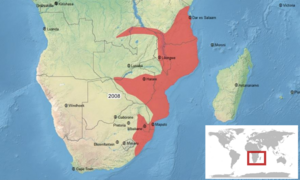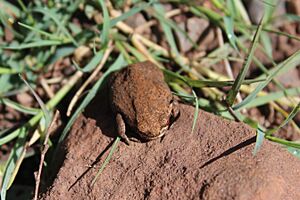Mozambique rain frog facts for kids
Quick facts for kids Mozambique rain frog |
|
|---|---|
 |
|
| Conservation status | |
| Scientific classification | |
 |
The Mozambique rain frog (Breviceps mossambicus) is a special kind of frog. It's also known as the flat-faced frog because of its unique look! This frog belongs to a family called Brevicipitidae.
You can find these frogs in many countries in Africa. They live in places like Botswana, Democratic Republic of the Congo, Eswatini, Malawi, Mozambique, South Africa, Tanzania, Zambia, and Zimbabwe. They might even live in Lesotho too!
These frogs like many different kinds of homes. They can live in dry savannas, moist savannas, and areas with lots of shrubland. You might also find them in grasslands, farm fields, pastures, and even gardens in the countryside.
Contents
What Does the Mozambique Rain Frog Look Like?
The Mozambique rain frog is a strong, chunky animal. It has short legs and a snout that isn't pointy. Female frogs can grow to be about 52 millimeters (about 2 inches) long from their snout to their rear end.
Their back is usually brownish-grey with darker spots. You might see a dark line that goes from their eye to their front leg, passing over their ear drum (called a tympanum). Their belly is white with dark patches. Male frogs have a brown throat.
These frogs have feet without webs between their toes. Their two outer toes are much smaller than the others. Sometimes, people might confuse this frog with other similar species. However, the Mozambique rain frog usually stays on the ground, unlike some other frogs that climb trees. Also, their calls are very unique!
Home Sweet Home: Where These Frogs Live
The Mozambique rain frog lives in a wide area across southern and central Africa. Their range stretches from the Democratic Republic of the Congo and Tanzania in the north, all the way down to South Africa in the south.
They prefer savannas, bushy areas, and open woodlands. They especially like the wetter parts of these places. You can find them in lowlands and on the lower parts of mountains, up to about 1,800 meters (about 5,900 feet) above sea level. These frogs are very good at adapting. They can even manage if their home changes a bit, like if people start building nearby.
Daily Life of the Rain Frog
When the weather is dry, the Mozambique rain frog likes to hide. They might go under rocks or find secret spots among tree roots. They eat small bugs and other tiny creatures without backbones, called invertebrates.
After a big rain, many flying termites often appear. When this happens, lots of these frogs come out to feast on them! It's like a big buffet for them.
Reproduction and Life Cycle
The Mozambique rain frog lays a small group of eggs, usually around 22. These eggs are rich in yolk and are laid in a round chamber. This chamber is often hidden under fallen leaves or a clump of grass.
Each egg is about 6 millimeters (about 0.24 inches) wide. With its protective covering, it's about twice that size. The baby frogs grow inside the eggs for about six to eight weeks. They develop directly into tiny froglets. This means there is no tadpole stage, and they don't need a pond or water body to reproduce.
The female frog often stays close to her eggs. She might stay outside the sealed egg chamber to protect them. This is a form of parental care.
How Many Rain Frogs Are There?
The IUCN Red List of Threatened Species keeps track of how many animals are in the wild. They list the Mozambique rain frog as "Least Concern". This is good news!
It means there are many of these frogs, and they live in a wide variety of places. They can also move to new areas if their original home is disturbed. Because of this, scientists are not worried about them disappearing anytime soon.





